This summer we were thrilled to welcome our first recipient of the Sal & Lori Santamaura Study Grant, Carson Poplin! Over her 8 week internship, Carson worked diligently with our Curators to research and date objects in our Rudi Gernreich Archive. For her intern report, Carson explored a donation of Mainbocher maternity gowns given to the Museum by Gloria Vanderbilt in 1995; read on to learn what she discovered about their provenance!
************************************************************************
I’ve always been interested in fashion and how it manifests itself in our culture, which is how I ended up as a graduate student at the Fashion Institute of Technology in New York and, currently, completing an internship here at the FIDM Museum. But I also love to learn about the people that wore fashion; how they lived in their clothes and what it contributes to their story.
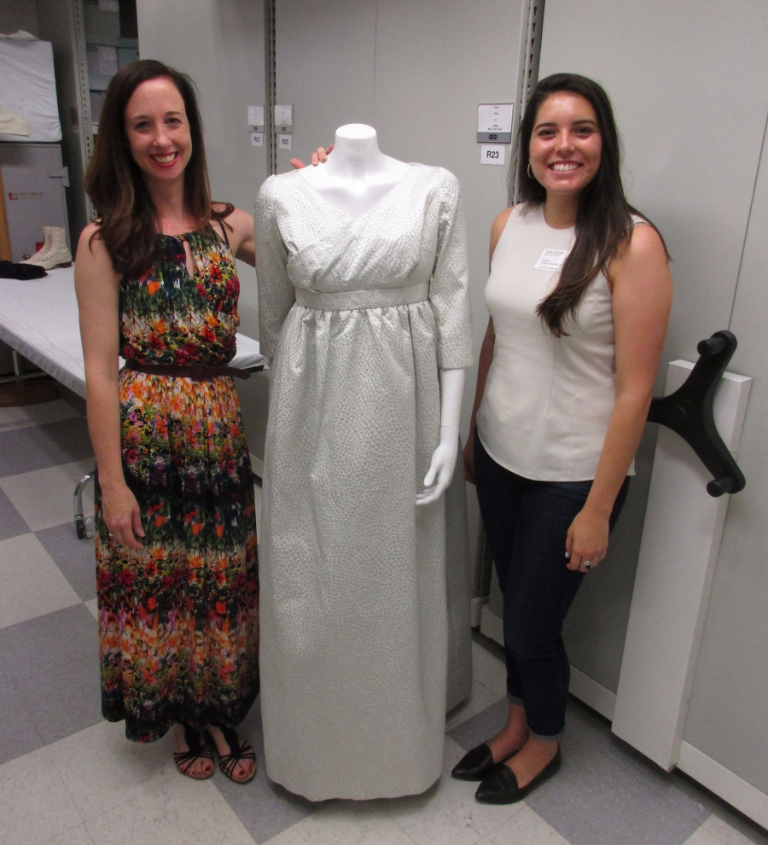 Associate Curator Christina (left) with Carson Poplin (right)
Associate Curator Christina (left) with Carson Poplin (right)
Going off this notion, Associate Curator Christina Johnson helped me identify objects in the Museum’s collection that fit this bill and were good candidates for further study. We landed upon the eternally compelling heiress, Gloria Vanderbilt (b. 1924). In 1995, she donated a number of garments from her personal wardrobe to the Museum. Many of them already had research associated with them, like a Bill Cunningham photograph of Vanderbilt in a Zoran dress and cape from 1992[1] and the family Christmas card in 1967 that shows her in a Cybil Conolly dress.[2]
Also in the donation were garments by Mainbocher (1890-1976), including two maternity evening gowns. Vanderbilt herself had identified both the gowns as being from the 1960s, the decade she had sons Carter and Anderson, with husband Wyatt Cooper. Both are long evening dresses with banded empire waists, three-quarter length sleeves and slight trains. One is made of a silver-white silk brocade and features a surplice neckline while the other is made from green cut and voided velvet and features raglan sleeves and a V-neck.
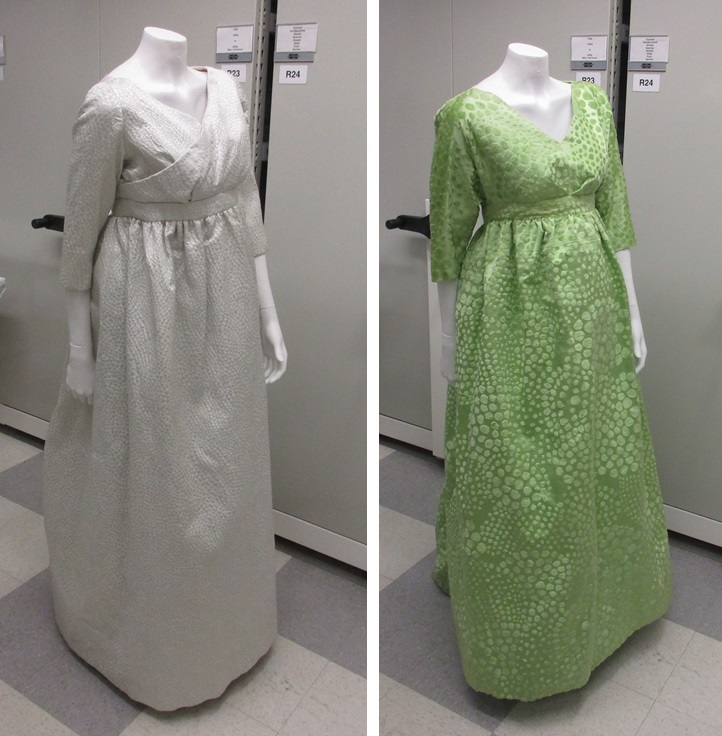 Mainbocher Maternity Gowns, Gift of Gloria Vanderbuilt. L: 1964, 95.1960s.59.27; R: c. 1964, 95.1960.59.28
Mainbocher Maternity Gowns, Gift of Gloria Vanderbuilt. L: 1964, 95.1960s.59.27; R: c. 1964, 95.1960.59.28
I began my research by learning about Vanderbilt herself, a woman who continues to lead a captivating life. Thanks to her famous last name, she has spent the majority of her 93 years in the public eye, making headlines. She was first photographed for Harper’s Bazaar when she was only 15 years old[3] and would go on to appear in publications like Vogue, Town & Country, and House & Garden throughout her lifetime.
Vanderbilt has reinvented herself numerous times, with the public always following along with great interest. In 2010, Anderson Cooper said of his mother, “She’s been an actress, an artist, a designer, a writer, a wife, a mother, a lover, a victim and a survivor. Every few years she seems to shed her old self, and is born anew.”[4] By the time Vanderbilt wore these gowns, she was married to her fourth husband and had established herself as an artist. A designer jeans empire and publishing numerous books were just some of the ventures yet to come.[5]
Vanderbilt first started patronizing Mainbocher, the man who may be best remembered for designing Wallis Simpson’s wedding dress for her marriage to the Duke of Windsor in 1937,[6] in the late 1950s[7] and stayed a loyal client to him throughout the 1960s.[8] Mainbocher spent his career as a couturier dressing well-to-do women in timeless styles up until his retirement in 1971.[9] A New York Times article from February 1964 boasted that Mainbocher’s “elegance suits a mature woman of means,”[10] essentially describing Vanderbilt to a T.
Women loved Mainbocher because of the versatility of his designs. In 1966, Vanderbilt was quoted saying that Mainbocher “makes it all so easy. You put on a Mainbocher and forget about it; it’s right and that’s that.”[11] Even the buying experience was easy, as she described saying, “To go there for a fitting is really like a ballet. The timing is so perfect, and there’s this incredible economy of doing what is really to the point.”[12]
It’s clear that in addition to their professional relationship, Mainbocher and Vanderbilt had great respect for one another. After working with Vanderbilt for more than half a decade, Mainbocher said of her, “Nobody is brighter about clothes; she comes in and picks things out right away…doesn’t even try them on before she decides what she wants.”[13]
The print media’s thorough coverage of all things Gloria Vanderbilt proved to be helpful, since I eventually stumbled across a New York Times article that featured a photograph of Vanderbilt wearing one of the maternity dresses.[14] She was attending the movie premiere of My Fair Lady on October 21, 1964, accompanied by her husband. The grainy image was captioned, “Her white silk brocade costume is by Mainbocher.” Though the image was blurry and the dress hard to discern, the dates checked out. In the 1960s, Vanderbilt was pregnant twice, giving birth in January 1965 to Carter Vanderbilt Cooper and in June 1967 to Anderson Hays Cooper. If the photograph was indeed of the dress in question, Vanderbilt would have been roughly six months pregnant with Carter when she wore it.
Photograph of Vanderbilt with husband, Wyatt Cooper, published in New York Times, October 22, 1964.
Further detective work found additional photographs of Vanderbilt and Cooper from that night. The dress worn to the premiere was the very same she would later donate to the FIDM Museum.
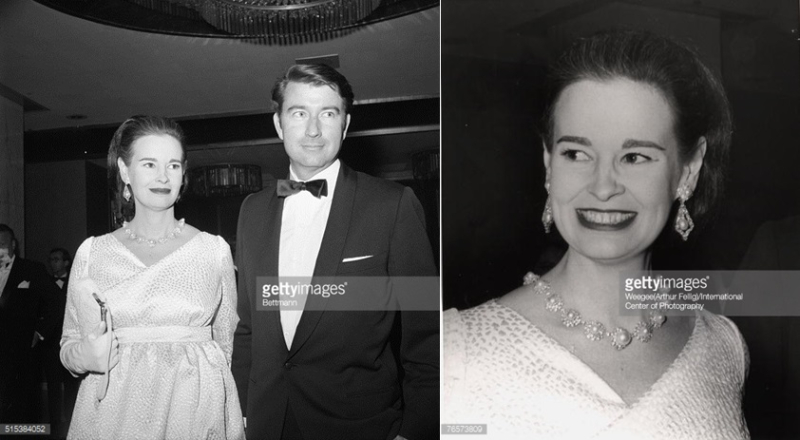 Arriving at the Criterion Theater on October 21, 1964. Getty Images.
Arriving at the Criterion Theater on October 21, 1964. Getty Images.
My luck didn’t extend far enough to find an exact match to the green maternity dress, at least not yet. But I was able to identify two extant garments that seem to be made from a similar textile as the lettuce-green velvet Mainbocher used. One, an evening dress dated 1960, was sold at auction last year by Augusta Auctions. Another, an evening coat now in the collection of the Metropolitan Museum of Art, is dated 1960-1965. Both skew closer to when Vanderbilt was pregnant in 1964. This, and the fact that both gowns are similar in cut and silhouette, make me think that they are from the same date.
The dresses themselves speak to the close relationship between Vanderbilt and Mainbocher. Maternity dresses were not typically included in Mainbocher’s couture lines, though fellow Mainbocher client Jeanne Murray Vanderbilt recalled a coatdress she “wore through two pregnancies. They made it with big seams so it could be let out and taken in.”[15] Similarly, these gowns are examples of super-custom couture, since they were made especially for Vanderbilt at a particular time in her life. While they may bear similar elements to other garments featured in Mainbocher’s couture lines that same year, such as textile and cut, it is doubtful that maternity dresses were his usual fare. However, the gowns still bear hallmarks of couture construction: overcast finishing on the seams, a lining in the skirt that is completely sewn in and a petersham ribbon in the waistline, all things that drew women like Vanderbilt to Mainbocher in the first place.
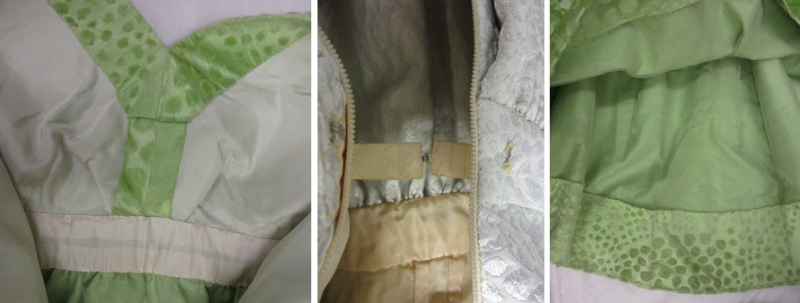 (left to right): Interior of bodice, the hem of the skirt with a generous hem allowance and sewn-in lining, petersham ribbon.
(left to right): Interior of bodice, the hem of the skirt with a generous hem allowance and sewn-in lining, petersham ribbon.
I’d like to think that such well-made gowns weren’t just a one-off for Vanderbilt and that she wore them through her next pregnancy as well. After all, women were known to wear his clothes for years. Vanderbilt once said, “They’re timeless and forever; whenever the seasons change and I open my closet I’m surprised and refreshed to rediscover my Mainbochers.”[16]
[1] “Honoring Alice Tully,” New York Times, September 20, 1992: V6.
[2] Wendy Goodman, The World of Gloria Vanderbilt (New York: Abrams, 2010), 156.
[3] Goodman, The World of Gloria Vanderbilt, 76.
[4] Anderson Cooper, “Lives: Leading Ladies: Gloria Vanderbilt,” Vogue, November 1, 2010: 108.
[5] Goodman, The World of Gloria Vanderbilt, 15, 183-4.
[6] Richard Martin and Harold Koda, Haute Couture (New York: The Metropolitan Museum of Art, 1995), 57.
[7] “Fashion: Miss Gloria Vanderbilt Dressed by Mainbocher,” Vogue, December 1, 1959: 133.
[8] Goodman, The World of Gloria Vanderbilt, 180.
[9] Sarah Tomerlin Lee, ed. American Fashion: The Life and Lines of Adrian, Mainbocher, McCardell, Norell, Trigere (New York: Quadrangle/The New York Times Book Co., 1975), 167.
[10] Marilyn Bender, “Mainbocher Remains Aloof in Changing World of Fashion,” New York Times, February 21, 1964: 19.
[11] “Fashion & Features: Mainbocher: Mrs. Wyatt Cooper Wears the New Main Suit Looks,” Vogue, April 15, 1966: 127.
[12] “Fashion: Miss Gloria Vanderbilt Dressed by Mainbocher,” Vogue, December 1, 1959: 133.
[13] “Fashion & Features: Mainbocher: Mrs. Wyatt Cooper Wears the New Main Suit Looks,” Vogue, April 15, 1966: 127.
[14] “Film Premiere Bring Out Ladies in Fairest Fashions,” New York Times, October 22, 1964: 40.
[15] “Fashion: Mainbocher: ‘I Only Deal with Reality,’” Vogue, November 1, 1962: 104.
[16] “Fashion: Mainbocher: ‘I Only Deal with Reality’,” Vogue, November 1, 1962: 170.

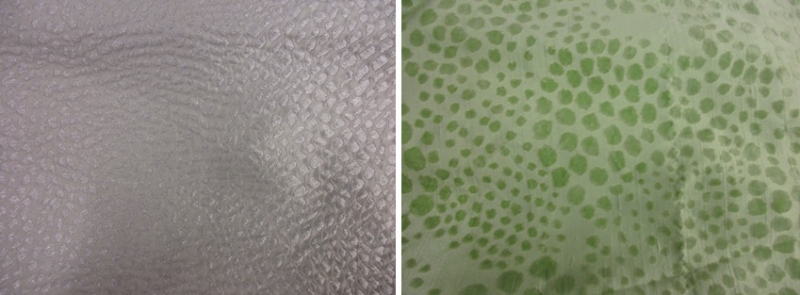

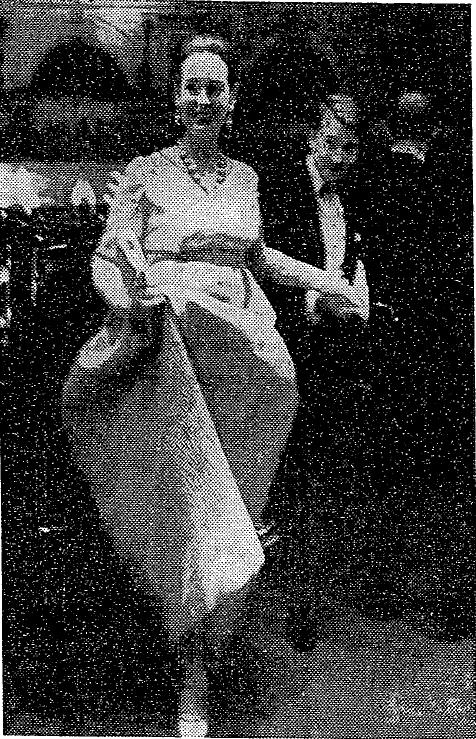
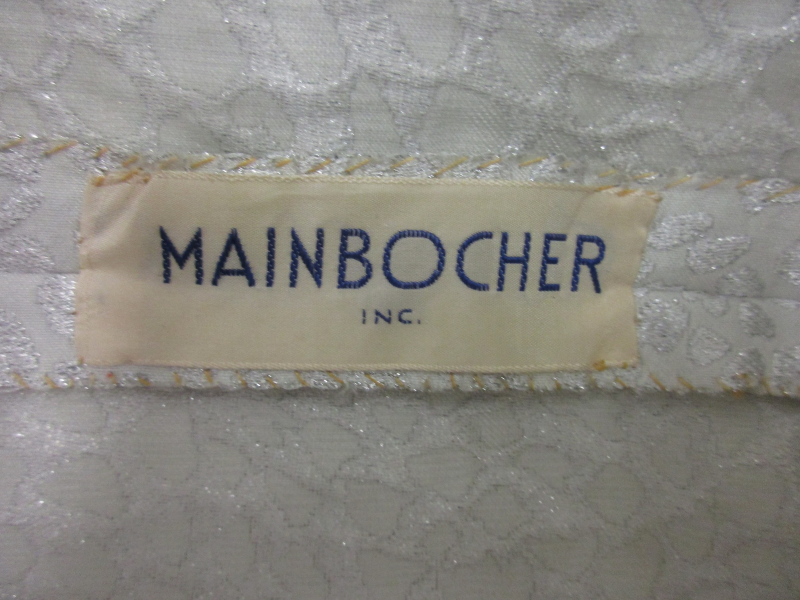

Absolutely fascinating, this is the kind of exploration into context I love! Thankyou for bringing these gowns back to life.